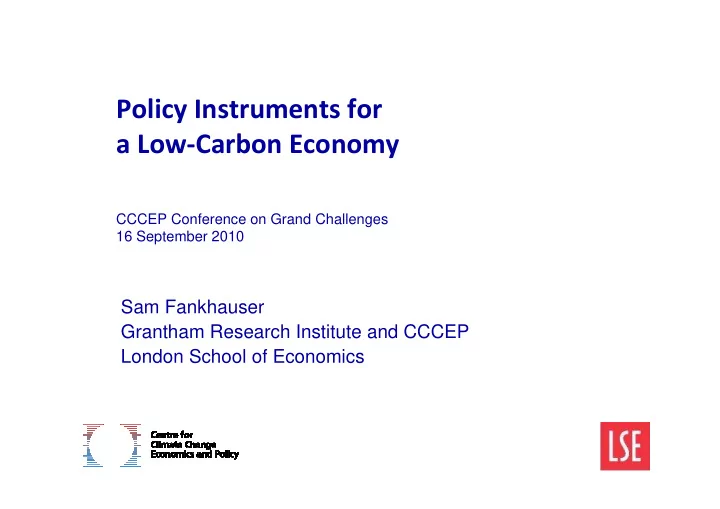

Policy Instruments for a Low-Carbon Economy CCCEP Conference on Grand Challenges 16 September 2010 Sam Fankhauser Grantham Research Institute and CCCEP London School of Economics
Overview • The key elements of carbon policy • Putting a price on carbon • Tax vs trade • Tax and trade • Hybrid instruments • Conclusions
The key elements of carbon policy Regulation Put a price Incentives on carbon Finance Support low-carbon technology Remove barriers to Taxes, energy efficiency Cap & trade R&D policy
Taxes vs permits: the basic Weitzman result Steep MB curve MAC Flat MB curve Marg. Abatement Cost Marg. Abatement Cost MB MAC MB target target
Taxes vs permits: the basic Weitzman result Choose permits MAC Choose tax Marg. Abatement Cost Marg. Abatement Cost MB MAC MB target target
Applying Weitzman to Climate Change • For stock pollutants the marginal damage curve is flat in the short run (Pizer, Hoel) • Because the atmospheric stock is large, emissions today have the same effect as emissions tomorrow • Some countries have adopted (more or less) binding carbon constraints (UK, all of Annex 1) • Meeting a fixed target through a price is expensive (Fehr): their marginal benefit curve is steep • Political economy favours cap and trade
Combining taxes with trade • Policy makers are increasingly willing to combine taxes with trade • Either to underpin the price (UK, France) or create a safety valve (US, Australia) • They also combine other market instruments with trade (e.g. renewable energy support) • Multiple market failures justify multiple instruments • e.g. the case for R&D support • But there can be unintended consequences
Example: UK policies parallel to the EU ETS • Tax and trade • Climate Change Levy • Subsidy and trade • Renewable heat incentive; small-scale feed in tariff • Trade on trade • CRC Energy Efficiency Scheme • Regulation and trade • Renewable energy obligation, energy performance standards
Combining taxes with trade: the simplest case A tax on top of the cap reduces the carbon price by the same amount. The overall price signal (t+p) is constant, but the carbon market is undermined MAC price t � p quantity cap target
Targeted taxes or subsidies may have the same effect The expensive mitigation action D (renewables?) is forced into the mix, reducing the price at the margin and crowding out action C MAC MAC MAC MAC MAC MAC MAC ($) ($) ($) ($) ($) ($) ($) p* p* p* p* p* p* p* $s $s $s $s $s $s $s F F F F F F F p’ p’ p’ p’ E E E E E E E D D D C C C C C C C B B B B B B B D D D D A A A A A A A Q Q Q Q Q Q* Q* Q* Q* Q* Q* Q* abatement abatement abatement abatement abatement
Support of intra-marginal activities creates rent MAC MAC MAC MAC MAC MAC ($) ($) ($) ($) ($) ($) p* p* p* p* p* p* F F F F F F E E E E E E $s $s $s $s $s $s $s $s D D D D D D C C C C C C B B B B A A A A A A B B B B Q Q Q Q Q Q* Q* Q* Q* Q* Q* abatement abatement abatement abatement abatement
Support of extra-marginal activities has no price effect MAC MAC MAC MAC ($) ($) ($) ($) $s $s $s $s $s $s p* p* p* p* F F F E E E E D D F F F D D C C C C B B B B A A A A Q Q Q Q Q* Q* Q* Q* abatement abatement abatement abatement
Hybrid instruments • Auction reserve price • Underpins the carbon price • Safety valve • Curtails the carbon price • Cap and collar • Combines reserve price and safety valve • Contract for differences • Stabilises the carbon price
Collar creates an upward sloping supply curve Reduces price fluctuation but introduces quantity uncertainty price price S = cap S � p � p D D D’ D’ � q q = const quantity quantity Fixed cap Collar
Conclusions • Price ceilings and underpins (cap and collar) may be justified if excessive price fluctuations are undesirable • Support for particular technologies (renewables, CCS) may be desirable from a long-term perspective • Subsidising the move down the learning curve • Hybrid instruments are better at stabilising the carbon price than pure tax and trade
Other work by the LSE Carbon Market Group • Linking regional cap-and-trade schemes • Hybrid schemes and other price containment mechanisms • Understanding Carbon Price Fluctuations • Understanding the CDM – EUA spread • Impact of Carbon Regulation on Technology Uptake and Innovation
Policy Instruments for a Low-Carbon Economy CCCEP Conference on Grand Challenges 16 September 2010 Sam Fankhauser Grantham Research Institute and CCCEP London School of Economics
Recommend
More recommend